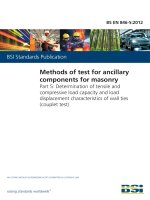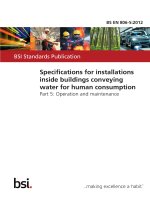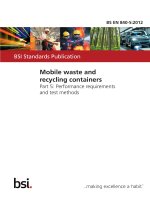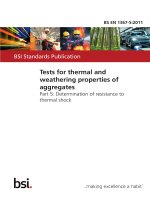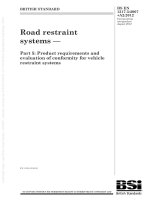Bsi bs en 62047 5 2011 (2012)
Bạn đang xem bản rút gọn của tài liệu. Xem và tải ngay bản đầy đủ của tài liệu tại đây (1.63 MB, 38 trang )
BS EN 62047-5:2011
Incorporating corrigendum March 2012
BSI Standards Publication
Semiconductor devices —
Micro-electromechanical
devices
Part 5: RF MEMS switches
NO COPYING WITHOUT BSI PERMISSION EXCEPT AS PERMITTED BY COPYRIGHT LAW
raising standards worldwide™
BRITISH STANDARD
BS EN 62047-5:2011
National foreword
This British Standard is the UK implementation of EN 62047-5:2011. It is
identical to IEC 62047-5:2011, incorporating corrigendum March 2012.
The start and finish of text introduced or altered by corrigendum is
indicated in the text bytags. Text altered by IEC corrigendum March 2012
is indicated in the text by ˆ‰.
The UK participation in its preparation was entrusted to
Technical Committee EPL/47, Semiconductors.
A list of organizations represented on this committee can be obtained
on request to its secretary.
This publication does not purport to include all the necessary provisions
of a contract. Users are responsible for its correct application.
© The British Standards Institution 2013.
Published by BSI Standards Limited 2013.
ISBN 978 0 580 78769 0
ICS 31.080.99
Compliance with a British Standard cannot confer immunity
from legal obligations.
This British Standard was published under the authority of the
Standards Policy and Strategy Committee on 30 September 2011.
Amendments/corrigenda issued since publication
Date
Text affected
30 April 2013
Implementation of IEC corrigendum March 2012
EUROPEAN STANDARD
EN 62047-5
NORME EUROPÉENNE
March 2012
EUROPÄISCHE NORM
ICS 31.080.99
English version
Semiconductor devices Micro-electromechanical devices Part 5: RF MEMS switches
(IEC 62047-5:2011)
Dispositifs à semiconducteurs Dispositifs microélectromécaniques Partie 5: Commutateurs MEMS-RF
(CEI 62047-5:2011)
Halbleiterbauelemente Bauelemente der Mikrosystemtechnik Teil 5: Hochfrequenz-MEMS-Schalter
(IEC 62047-5:2011)
This European Standard was approved by CENELEC on 2011-08-17. CENELEC members are bound to comply
with the CEN/CENELEC Internal Regulations which stipulate the conditions for giving this European Standard
the status of a national standard without any alteration.
Up-to-date lists and bibliographical references concerning such national standards may be obtained on
application to the Central Secretariat or to any CENELEC member.
This European Standard exists in three official versions (English, French, German). A version in any other
language made by translation under the responsibility of a CENELEC member into its own language and notified
to the Central Secretariat has the same status as the official versions.
CENELEC members are the national electrotechnical committees of Austria, Belgium, Bulgaria, Croatia, Cyprus,
the Czech Republic, Denmark, Estonia, Finland, France, Germany, Greece, Hungary, Iceland, Ireland, Italy,
Latvia, Lithuania, Luxembourg, Malta, the Netherlands, Norway, Poland, Portugal, Romania, Slovakia, Slovenia,
Spain, Sweden, Switzerland and the United Kingdom.
CENELEC
European Committee for Electrotechnical Standardization
Comité Européen de Normalisation Electrotechnique
Europäisches Komitee für Elektrotechnische Normung
Management Centre: Avenue Marnix 17, B - 1000 Brussels
© 2011 CENELEC -
All rights of exploitation in any form and by any means reserved worldwide for CENELEC members.
Ref. No. EN 62047-5:2011 E
BS EN 62047-5:2011
EN 62047-5:2011 (E)
–2–
Foreword
The text of document 47F/83/FDIS, future edition 1 of IEC 62047-5, prepared by SC 47F, Microelectromechanical systems, of IEC TC 47, Semiconductor devices, was submitted to the IEC-CENELEC
parallel vote and was approved by CENELEC as EN 62047-5 on 2011-08-17.
Attention is drawn to the possibility that some of the elements of this document may be the subject of
patent rights. CEN and CENELEC shall not be held responsible for identifying any or all such patent
rights.
The following dates were fixed:
– latest date by which the EN has to be implemented
at national level by publication of an identical
national standard or by endorsement
(dop)
2012-05-17
– latest date by which the national standards conflicting
with the EN have to be withdrawn
(dow)
2014-08-17
Annex ZA has been added by CENELEC.
__________
Endorsement notice
The text of the International Standard IEC 62047-5:2011 was approved by CENELEC as a European
Standard without any modification.
__________
BS EN 62047-5:2011
EN 62047-5:2011 (E)
–3–
Annex ZA
(normative)
Normative references to international publications
with their corresponding European publications
The following referenced documents are indispensable for the application of this document. For dated
references, only the edition cited applies. For undated references, the latest edition of the referenced
document (including any amendments) applies.
NOTE When an international publication has been modified by common modifications, indicated by (mod), the relevant EN/HD
applies.
Publication
Year
Title
EN/HD
Year
IEC 60747-1
+ corr. August
2006
2008
Semiconductor devices Part 1: General
-
-
IEC 60747-16-1
-
Semiconductor devices Part 16-1: Microwave integrated circuits Amplifiers
EN 60747-16-1
-
IEC 60747-16-4
2004
Semiconductor devices Part 16-4: Microwave integrated circuits Switches
EN 60747-16-4
2004
IEC 60749-5
-
Semiconductor devices - Mechanical and
climatic test methods Part 5: Steady-state temperature humidity
bias life test
EN 60749-5
-
IEC 60749-10
-
Semiconductor devices - Mechanical and
climatic test methods Part 10: Mechanical shock
EN 60749-10
-
IEC 60749-12
-
Semiconductor devices - Mechanical and
climatic test methods Part 12: Vibration, variable frequency
EN 60749-12
-
IEC 60749-27
-
Semiconductor devices - Mechanical and
climatic test methods Part 27: Electrostatic discharge (ESD)
sensitivity testing - Machine model (MM)
EN 60749-27
-
BS EN 62047-5:2011
EN 62047-5:2011 (E)
–4–
CONTENTS
1
Scope ............................................................................................................................... 6
2
Normative references ....................................................................................................... 6
3
Terms and definitions ....................................................................................................... 6
4
3.1 Switching operation ................................................................................................. 7
3.2 Switching configuration ........................................................................................... 7
3.3 Actuating mechanism .............................................................................................. 7
3.4 Switching network configurations ............................................................................. 8
3.5 Reliability (performance) ......................................................................................... 8
3.6 Electrical characteristics .......................................................................................... 9
Essential ratings and characteristics ............................................................................... 10
5
4.1 Identification and types ......................................................................................... 10
4.2 Application and specification description ............................................................... 11
4.3 Limiting values and operating conditions ............................................................... 11
4.4 DC and RF characteristics ..................................................................................... 11
4.5 Mechanical and environmental characteristics ....................................................... 12
4.6 Additional information ............................................................................................ 12
Measuring methods ........................................................................................................ 12
5.1
6
General ................................................................................................................. 12
5.1.1 General precautions .................................................................................. 12
5.1.2 Characteristic impedances ......................................................................... 12
5.1.3 Handling precautions ................................................................................. 12
5.1.4 Types ........................................................................................................ 12
5.2 DC characteristics ................................................................................................. 12
5.2.1 DC actuation voltage ................................................................................. 12
5.2.2 On or off resistance (d.c. contact or resistive type) .................................... 14
5.2.3 On or off capacitance (capacitive type) ...................................................... 15
5.2.4 Power consumption ................................................................................... 16
5.3 RF characteristics ................................................................................................. 17
5.3.1 Insertion loss (L ins ) .................................................................................... 17
5.3.2 Isolation (L iso ) ........................................................................................... 19
5.3.3 Voltage standing wave ratio (VSWR) ......................................................... 20
5.3.4 Input power at the intercept point .............................................................. 21
5.4 Switching characteristics ....................................................................................... 21
5.4.1 General ..................................................................................................... 21
5.4.2 Switching time measurement ..................................................................... 21
Reliability (performance)................................................................................................. 22
6.1
6.2
6.3
General ................................................................................................................. 22
Life time cycles ..................................................................................................... 22
6.2.1 General ..................................................................................................... 22
6.2.2 Cold switching ........................................................................................... 23
6.2.3 Hot switching or power handling ................................................................ 23
Temperature cycles ............................................................................................... 24
6.3.1 General ..................................................................................................... 24
6.3.2 Test temperature ....................................................................................... 24
6.3.3 Test cycle .................................................................................................. 24
–5–
6.4
6.5
6.6
6.7
Annex A
BS EN 62047-5:2011
EN 62047-5:2011 (E)
High temperature and high humidity testing ........................................................... 24
Shock testing ........................................................................................................ 25
Vibration testing .................................................................................................... 25
Electrostatic discharge (ESD) sensitivity testing .................................................... 25
(informative) General description of RF MEMS Switches........................................ 26
Annex B (informative) Geometry of RF MEMS switches ....................................................... 27
Annex C (informative) Packaging of RF MEMS switches ...................................................... 30
Annex D (informative) Failure mechanism of RF MEMS switches ......................................... 31
Annex E (informative) Applications of RF MEMS switches ................................................... 32
Annex F (informative) Measurement procedure of RF MEMS switches ................................. 34
Figure 1 – Terminals of RF MEMS switch ............................................................................. 11
Figure 2 – Circuit diagram for measuring d.c. actuation voltage and RF characteristics
of RF MEMS switches ........................................................................................................... 13
Figure 3 – Circuit diagram for measuring impedance between the input and output
ports ..................................................................................................................................... 14
Figure 4 – Circuit diagram for measuring RF characteristics between the input and
output ports using a network analyzer ................................................................................... 18
Figure 5 – Circuit block diagram of a test setup to evaluate life time of RF MEMS
switch ................................................................................................................................... 22
Figure 6 – Circuit block diagram of a test setup for power handling capability of RF
MEMS switch ........................................................................................................................ 24
Figure B.1 – RF MEMS series d.c. contact switch with two contact areas. ............................. 27
Figure B.2 – RF MEMS series d.c. contact switch with one contact area ............................... 27
Figure B.3 – RF MEMS shunt d.c. contact switch .................................................................. 28
Figure B.4 – RF MEMS series capacitive type switch with one contact area .......................... 28
Figure B.5 – RF MEMS shunt capacitive type switch ............................................................. 29
Figure F.1 – Measurement procedure of RF MEMS switches ................................................ 34
Table A.1 – Comparison of semiconductor and RF MEMS switches ...................................... 26
Table B.1 – Comparison of RF MEMS switches with different actuation mechanism .............. 29
Table D.1 – Comparison of failure mechanism of RF MEMS switches ................................... 31
BS EN 62047-5:2011
EN 62047-5:2011 (E)
–6–
SEMICONDUCTOR DEVICES –
MICRO-ELECTROMECHANICAL DEVICES –
Part 5: RF MEMS switches
1
Scope
This part of IEC 62047 describes terminology, definition, symbols, test methods that can be
used to evaluate and determine the essential ratings and characteristic parameters of RF
MEMS switches. The statements made in this standardization are also applicable to RF
(Radio Frequency) MEMS (Micro-Electro-Mechanical Systems) switches with various
structures, contacts (d.c. contact and capacitive contact), configurations (series and shunt),
switching networks (SPST, SPDT, DPDT, etc.), and actuation mechanism such as
electrostatic, electro-thermal, electromagnetic, piezoelectric, etc. The RF MEMS switches are
promising devices in advanced mobile phones with multi-band/mode operation, smart radar
systems, reconfigurable RF devices and systems, SDR (Software Defined Radio) phones, test
equipments, tunable devices and systems, satellite, etc.
2
Normative references
The following referenced documents are indispensable for the application of this document.
For dated references, only the edition cited applies. For undated references, the latest edition
of the normative documents (including any amended documents) referred to applies.
IEC 60747-1: 2006, Semiconductor devices – Part 1: General
IEC 60747-16-1, Semiconductor devices – Part 16-1: Microwave integrated circuits –
Amplifiers
IEC 60747-16-4:2004, Semiconductor devices – Part 16-4: Microwave integrated circuits –
Switches
IEC 60749-5, Semiconductor devices – Mechanical and climatic test methods – Part 5:
Steady-state temperature humidity bias life test
IEC 60749-10, Semiconductor devices – Mechanical and climatic test methods – Part 10:
Mechanical shock
IEC 60749-12, Semiconductor devices – Mechanical and climatic test methods – Part 12:
Vibration, variable frequency
IEC 60749-27, Semiconductor devices – Mechanical and climatic test methods – Part 27:
Electrostatic discharge (ESD) sensitivity testing – Machine model (MM)
3
Terms and definitions
For the purposes of this document, the following terms and definitions apply.
NOTE In the text of this standard, the term of switch is used instead of RF MEMS switch to improve the
readability.
–7–
3.1
BS EN 62047-5:2011
EN 62047-5:2011 (E)
Switching operation
3.1.1
capacitive switch
switch whereby an RF signal is passed or blocked by a change of impedance ratio caused by
the capacitive effect of making contact using a movable metal plate onto a dielectric film
presented on a fixed metal plate
3.1.2
d.c. contact switch
switch whereby an RF signal is passed or blocked by a movable metal contact
3.2
Switching configuration
3.2.1
series switch
switch whereby an RF signal applied to the input port is directly passed to the output port
when a movable plate makes contact with a fixed plate
3.2.2
shunt switch
switch whereby an RF signal applied to the input port is passed to the ground plane when a
movable plate makes contact with a fixed plate
3.3
Actuating mechanism
3.3.1
electro-statically actuated switch
switch whereby a ˆmoving plate‰ is pulled down onto the fixed plate by an electrostatic force
caused by the applied d.c. bias voltage, the moving plate returns to its original position when
the bias voltage is removed
NOTE Advantages are virtually zero power consumption, small electrode size, relatively short switching time, and
relatively simple fabrication and disadvantage is higher actuation voltage.
3.3.2
electro-magnetically actuated switch
switch whereby a movable plate or armature is pulled down onto a fixed plate by a magnetic
force generated by a permanent magnet or an energised electromagnet
NOTE Advantage is a low actuation voltage and disadvantages are complexity of fabrication and high power
consumption.
3.3.3
electro-thermally actuated switch
switch whereby a movable plate constructed of two or more differing materials with differential
thermal expansion coefficients deflects to contact a fixed plate or electrode
NOTE Advantages are nearly linear deflection-versus-power relations and environmental ruggedness and
disadvantages are high power consumption, low bandwidth, and relatively complex fabrication.
3.3.4
piezo-electrically actuated switch
switch whereby a movable ˆplate‰ constructed of piezoelectric materials deflects to contact a
fixed plate or electrode
BS EN 62047-5:2011
EN 62047-5:2011 (E)
3.4
–8–
Switching network configurations
3.4.1
single-pole-single-throw switch
SPST
device with a single input and a single output, which is providing an ON-OFF switching
function with switch actuation
3.4.2
single-pole-double-throw switch
SPDT
device with a single input and two outputs, which is transferring the through connection from
one output to the other output with switch actuation
3.4.3
single-pole-multi-throw switch
SPMT
device with one input and multiple outputs whereby connection to one or the other of the
multiple outputs is determined by switch actuation
3.4.4
double-pole-double- throw switch
DPDT
device with two inputs and two outputs, which is transferring the through connection from one
output to the other output with switch actuation
3.4.5
multi-pole-multi-throw switch
MPMT
device with multi inputs and outputs, which is transferring the through connection from multi
outputs to the other multi outputs with switch actuation
3.5
Reliability (performance)
3.5.1
life time cycles
number of actuating times which the switches are operating with satisfactory electrical
performances in the on/off positions
NOTE Unlike the electronic switch, a mechanical switch may fail due to stiction (micro-welding and material
transfer) of a moving part and degradation of metal to metal contact used, whereas at electronic RF switches
(capacitive switch) the reliability is limited by dielectric charging (charge injection and charge trapping).
3.5.2
cold switching
performed switching where the RF power is not applied during the switch operation
NOTE It is useful for examining the durability of the switch electrode to see if it can withstand the physical
stresses of repeated switching.
3.5.3
hot switching
performed switching where the RF power is applied during the switch operation
NOTE The hot-switching tests are indicative of how the switch will survive under actual operating conditions, with
current flowing through the device.
–9–
3.6
BS EN 62047-5:2011
EN 62047-5:2011 (E)
Electrical characteristics
3.6.1
d.c. characteristics
3.6.1.1
actuation voltage
d.c. voltage for the movable electrode (or membrane) of the switch being collapsed down onto
the fixed plate and kept securing RF characteristics desired
3.6.1.2
on resistance – DC contact type
electrical resistance which is measured across fully closed contacts at their associated
external terminals
3.6.1.3
off resistance – DC contact type
electrical resistance which is measured across fully opened contacts at their associated
external terminals
3.6.1.4
on capacitance – Capacitive type
electrical capacitance which is measured in the down-state position (the movable electrode
collapsed down on the dielectric layer on top of the fixed electrode) of the switch
3.6.1.5
off capacitance – Capacitive type
electrical capacitance which is measured in the up-state position of the switch (before the
movable electrode is being actuated)
3.6.1.6
power consumption
power consumed to pull down and hold the movable plate onto the fixed electrode when the
switch is ON
3.6.2
RF characteristics
3.6.2.1
insertion loss
[IEC 60747-16-4:2004, 3.1]
3.6.2.2
isolation
[IEC 60747-16-4:2004, 3.2]
NOTE It is caused by a RF energy leak from one conductor to another by radiation, ionization, capacitive coupling,
or Inductive coupling.
3.6.2.3
return loss
[IEC 60747-16-4:2004, 3.3]
3.6.2.4
voltage standing wave ratio
VSWR
ratio of the electrical field strength at a voltage maximum on a transmission line to the
electrical field strength of an adjacent voltage minimum
BS EN 62047-5:2011
EN 62047-5:2011 (E)
– 10 –
3.6.2.5
resonant frequency
frequency occurred at LC series resonance when the switch is up-state and down-state
position, respectively
3.6.2.6
bandwidth
frequency range where the switch has good RF characteristics enough to use in subsystems
and system applications
NOTE It is usally expressed as either the frequency or percentage differences between the lower or the upper
relative 1 dB points of the frequency response curve.
3.6.2.7
power handling capability
capability of a switch to transmit a given amount of power through the device when the switch
is on
3.6.3
Switching characteristics
3.6.3.1
self actuation power
radio frequency power where the switch movable plate is self-actuated without any voltages
being applied directly to it
3.6.3.2
switching time
3.6.3.2.1
turn on time
[IEC 60747-16-4:2004, 3.6]
3.6.3.2.2
turn off time
[IEC 60747-16-4:2004, 3.7]
3.6.3.2.3
rise time
transition time of the switch from OFF to ON state
NOTE
OFF state: 10 % of C up , ON state: 90 % of C down .
[IEC 60747-16-4:2004, 3.8]
3.6.3.2.4
falling time
transition time of the switch from ON to OFF state
[IEC 60747-16-4:2004, 3.9]
4
4.1
Essential ratings and characteristics
Identification and types
General description of the function of RF MEMS switches and their applications should be
stated. The statement should include the details of manufacturing technologies about the RF
MEMS switches with different operation, configuration, and actuation mechanism. The
BS EN 62047-5:2011
EN 62047-5:2011 (E)
– 11 –
statement should also include packaged form including terminal numbering and package
materials.
See 4.1 of IEC 60747-16-4:2004.
4.2
Application and specification description
Information on application of the RF MEMS switch shall be given. Block diagrams of RF
MEMS switches and the applied systems should be also given. All terminals should be
identified in the block diagram and their functions shall also be stated.
See 4.2 and 4.3 of IEC 60747-16-4:2004.
Control voltages or currents
NU
Inputs
RFMEMS
Switch
Outputs
NC
Ground
IEC
NOTE
1640/11
NC is a non-connected terminal and NU is a non-usable terminal.
Figure 1 – Terminals of RF MEMS switch
4.3
Limiting values and operating conditions
This statement should include limiting conditions and values. In particular, electrical limiting
values (control voltages or control currents, input power, handling power, power dissipation,
etc.) and temperature conditions (operating, ambient, storage, and soldering) shall be given in
the statement. These values are indicated within the table including the note.
Parameters (note)
Symbols
Min.
Max.
Unit
See 4.4 and 4.5 of IEC 60747-16-4:2004
4.4
DC and RF characteristics
DC and RF characteristic parameters shall be stated with Min., Nominal, and Max. in a table
form.
BS EN 62047-5:2011
EN 62047-5:2011 (E)
Characteristics
4.5
– 12 –
Symbols
Conditions
Min.
Nominal
Max.
Unit
Mechanical and environmental characteristics
Any specific mechanical characteristics and environmental ratings applicable shall be stated.
The characteristics shall be stated with Symbol, Unit, Min, Nominal, and Max. in a table form.
See 4.6 of IEC 60747-16-4:2004.
4.6
Additional information
Some additional information shall be given such as equivalent input and output circuits (eg.
Input/output impedance, d.c. block capacitors, etc.), internal protection circuits against high
static voltages or electric fields, handling precautions, and application data/information, etc.
See 4.8 of IEC 60747-16-4:2004.
5
Measuring methods
5.1
General
This clause prescribes measuring methods for electrical characteristics of RF MEMS switches
used at d.c. to microwave frequency bands.
5.1.1
General precautions
Special care shall be taken to use d.c. supplies, the input RF power supplies, and all bias
supply voltages for the measurement of RF MEMS switches. The level of the input and/or
output signal shall be specified in either power or voltage.
5.1.2
Characteristic impedances
The input and output characteristic impedances of the measurement systems are 50
they are not 50 Ω , they shall be specified.
5.1.3
Ω . If
Handling precautions
See Clause 8 of IEC 60747-1:2006.
5.1.4
Types
RF MEMS switches in this standard are both packaged and chip types, measured using
suitable test equipments and fixtures.
5.2
DC characteristics
5.2.1
5.2.1.1
DC actuation voltage
Purpose
To measure the optimal control d.c. voltage to satisfy the desired RF characteristics.
BS EN 62047-5:2011
EN 62047-5:2011 (E)
– 13 –
5.2.1.2
Circuit diagram
Figure 2 shows a circuit diagram for measuring d.c. actuation voltage and RF characteristics
of RF MEMS switches.
RF signal
generator
Signal
amplifier
Bias tee or
DC block
Bias tee or
DC block
Isolator
Attenuator
DUT
dB
Termination
W
V
Power
meter 1
Termination
A
Control power
supply
Spectrum
analyzer
W
Power
meter 2
IEC
1641/11
Key
Components and meters to monitor
Equipments and supplies
DUT: device
under test
a piece of RF MEMS switches
RF signal generator:
to supply a specified RF signal to a
type of the signal amplifier
V:
DC voltage source for operating
the DUT
Signal amplifier:
to apply a level of amplified signal to
the input port of a piece of DUT
through the isolator
A:
DC current source for operating
the DUT
Isolator:
to apply the amplified input power to a
piece of DUT without being returned to
a signal amplifier
W:
power (watt) meter to monitor
output power (watt) value of a
piece of testing device
Bias tee or d.c. block:
to block a level of d.c. signal between
the input and output orts of the DUT
dB:
attenuator to reduce the output
power of DUT for protecting the
spectrum analyzer
Control power supply:
to apply a specified bias voltage to a
piece of DUT
Spectrum
analyzer:
to measure the spectrum through
the DUT
Termination:
to keep the measured power level
steady
NOTE 1
ports.
The control bias for RF MEMS switch is supplied to become ON or OFF between the input and output
NOTE 2 The purpose of the isolator is to enable the power level to the device being measured to be kept constant
without considering the mismatched input impedance. Bias tee is used to block the d.c. signal between the input
and output ports of device being measured.
Figure 2 – Circuit diagram for measuring d.c. actuation voltage
and RF characteristics of RF MEMS switches
5.2.1.3
Principle of measurement
When a control voltage keeps increasing between the driving electrodes (a movable electrode
and a fixed electrode), it is measured during the movable plate of the RF MEMS switch being
collapsed down onto the fixed plate and kept securing the desired RF characteristics.
5.2.1.4
Measurement procedure
The frequency of the RF signal generator shall be set to the specified value.
An adequate input power shall be applied to the device being measured.
BS EN 62047-5:2011
EN 62047-5:2011 (E)
– 14 –
The control dc bias voltage will be applied and varied to find the desired output power which
is close to the input power.
When the desired output power is obtained, the dc bias voltage is recorded as the optimal d.c.
actuation voltage.
5.2.1.5
Specified conditions
The specified conditions are as follows:
–
ambient or reference-point temperature;
–
bias conditions;
–
frequency;
–
input power;
–
desired RF characteristics;
–
port being measured.
5.2.2
On or off resistance (d.c. contact or resistive type)
5.2.2.1
Purpose
To measure the dc (or low frequency) resistance between the input and output ports under
‘ON’ or ‘OFF’ conditions.
5.2.2.2
Circuit diagram
Figure 3 shows a circuit diagram for measuring impedance between the input and output ports.
DUT
Impedance
analyzer
V
A
Control power supply
IEC
1642/11
Key
Components and meters to monitor
Equipments and supplies
DUT: device
under test
a piece of RF MEMS switch
Control power supply:
to apply a specified bias voltage to a
piece of DUT
V:
DC voltage source for operating
the DUT
Impedance analyzer:
to measure impedance between the
input and output ports of the DUT
A:
DC current source for operating
the DUT
NOTE
The control bias is supplied to become ON between the input and output ports.
Figure 3 – Circuit diagram for measuring impedance
between the input and output ports
BS EN 62047-5:2011
EN 62047-5:2011 (E)
– 15 –
5.2.2.3
Principle of measurement
The on resistance, R on and off resistance, R off are derived from the impedance between the
input and output ports in the unit of ohms. The resistance is being measured as follows:
R on = re (Z on )
ˆ(1)‰
R off = re (Z off )
ˆ(2)‰
where
Z on and Z off are the values indicated by the impedance analyzer.
5.2.2.4
Measurement procedure
A calibration of the impedance analyzer shall be made in order to eliminate systematic error in
the impedance analyzer, cable, and connectors.
Impedance of open and short circuit, impedances of 50
shall be performed and stored.
Ω , and through standard calibration
When the actuation voltage is applied to the device being measured, its impedance will be
displayed.
The real value of the measured impedance is treated as the ON resistance as described in
5.2.2.3.
NOTE Instead of the impedance analyzer, multi-meter or LCR meter can also be applied to measure the on/off
resistance directly.
5.2.2.5
Specified conditions
The specified conditions are as follows:
–
ambient or reference-point temperature;
–
bias conditions;
–
port being measured.
5.2.3
5.2.3.1
On or off capacitance (capacitive type)
Purpose
To measure the series capacitance between the input and output ports under ‘ON’ or ‘OFF’
conditions.
5.2.3.2
Circuit diagram
The measurement circuit is the same as shown in Figure 3.
5.2.3.3
Principle of measurement
The on capacitance, C on and off capacitance, C off are derived from the impedance between
the input and output ports in units of farad. The capacitance is being measured as follows:
C on = -1/ (ω(im(1/Z on ))) = -1/ (2πf(im(1/Z on )))
ˆ(3)‰
C off = -1/ (ω(im(1/Z off ))) = -1/ (2πf(im(1/Z off )))
ˆ(4)‰
BS EN 62047-5:2011
EN 62047-5:2011 (E)
– 16 –
where
Z on and Z off are the values indicated by the impedance analyzer, and
C on and C off are expressed in farad.
5.2.3.4
Measurement procedure
A calibration of the impedance analyzer shall be made in order to eliminate systematic error in
the impedance analyzer, cable, and connectors.
Impedance of open and short circuit, impedances of 50
shall be performed and stored.
Ω , and through standard calibration
When the actuation voltage is applied to the device being measured, its impedance will be
displayed.
The imagery value of the measured impedance is divided by the measured angular frequency,
ω as described in 5.2.3.3.
NOTE Instead of the impedance analyzer, multi-meter or LCR meter can also be applied to measure the on/off
capacitance directly.
5.2.3.5
Specified conditions
The specified conditions are as follows:
–
ambient or reference-point temperature;
–
bias conditions;
–
frequency;
–
port being measured.
5.2.4
5.2.4.1
Power consumption
Purpose
To measure the power consumption under specified conditions.
NOTE Power is consumed to pull down and hold the movable plate onto the fixed electrode when the RF MEMS
switch is ON or OFF.
5.2.4.2
Circuit diagram
See Figure 2 described in 5.2.1.2.
5.2.4.3
Principle of measurement
The consumed power is derived from the following equation:
P = IV
where
I is the current on control bias;
V is the voltage on control bias;
P is expressed in watt.
5.2.4.4
Measurement procedure
The frequency of the RF signal generator shall be set to the specified value.
ˆ(5)‰
– 17 –
BS EN 62047-5:2011
EN 62047-5:2011 (E)
An adequate input power shall be applied to the device being measured.
The control dc bias voltage will be applied and varied to find the desired output power which
is close to the input power.
When the desired output power is obtained, the used control dc voltage or current of the RF
MEMS switch is recorded and utilized to calculate the consumed power by using the ˆ Equation
(5)‰ described in 5.2.4.3.
5.2.4.5
Specified conditions
The specified conditions are as follows:
–
ambient or reference-point temperature;
–
bias conditions;
–
frequency;
–
port being measured.
5.3
RF characteristics
5.3.1
5.3.1.1
Insertion loss (L ins )
Purpose
To measure the insertion loss between the input and output ports under ‘ON’ condition.
5.3.1.2
Circuit diagram
Figure 4 shows a circuit diagram for measuring RF characteristics between the input and
output port using a network analyzer.
BS EN 62047-5:2011
EN 62047-5:2011 (E)
– 18 –
AC
AC
power source
power
network
analyzer
Network
analyzer
Transfer
switch
transfer switch
Reference
meter
reference
meter
A
B
1
port Port
1
Test
test
cable
cable
Port22
port
DUT DUT
Test
test
cable
cable
V
A
control power
power supply
Control
supply
IEC
1643/11
Key
Components and meters to monitor
Equipments and supplies
DUT: device
under test
a piece of RF MEMS switches
AC power source:
to supply a specified level of electric
power to a type of transfer switch
V:
DC voltage source for operating
the DUT
Transfer switch:
to transfer a specified input power by
switching toward port 1 and port 2
A:
DC current source for operating
the DUT
Control power supply:
to apply a specified bias voltage to a
piece of DUT
A (channel):
to detect port 1 reflected from
the input of a piece of DUT
Network analyzer:
to measure S-parameters through a
piece of DUT
B (channel):
to detect port 2 power
transmitted through the DUT
Reference
meter:
to detect supplying electric
power in watt to keep a specified
level
NOTE 1 Ref channel is to detect source power for the reference. A channel is to detect Port 2 power reflected
from the input of device being measured and B channel is to detect Port 2 power transmitted through the device.
NOTE 2
Other test equipments and set-ups can be used instead of the network analyzer.
Figure 4 – Circuit diagram for measuring RF characteristics between the input
and output ports using a network analyzer
5.3.1.3
Principle of measurement
When the incident power is applied to the input port of RF MEMS switch, it is a measured
ratio between the transmitted power into the output port and the incident power. The insertion
loss of the switch is calculated from the measured S-parameter, S 21 . The Insertion loss, L ins
is normally expressed in decibels (dB). It has a logarithmic expression of a ratio between two
quantities (commonly voltage, current, or power),
Lins = −20 log( S 21 )[dB] (switch is on)
ˆ(6)‰
– 19 –
BS EN 62047-5:2011
EN 62047-5:2011 (E)
When the VNA (vector network analyzer) is not used, see 5.2 of IEC 60747-16-4:2004.
5.3.1.4
Measurement procedure
The measurement set-up is shown in Figure 4. An RF signal from the RF output Port 1 of a
network analyzer is directly fed to Port 2 through a device being measured. Before connecting
a device being measured, a calibration shall be made in order to eliminate systematic errors
in the network analyzer, cable, and connectors.
The full 2-port calibration technique is highly recommended. Impedance of open and short
circuit, impedances of 50 Ω , and through standard calibration shall be performed and stored
in order.
After calibration, connect the device being measured at the place indicated in Figure 4. When
the actuation voltage is applied to the device being measured (the switch is mechanically or
electrically connected), its S-parameter shall be measured using the network analyzer.
5.3.1.5
Specified conditions
The specified conditions are as follows:
–
ambient or reference-point temperature;
–
bias conditions;
–
frequency;
–
port being measured.
5.3.2
5.3.2.1
Isolation (L iso )
Purpose
To measure the isolation between the input and output ports under ‘OFF’ conditions.
5.3.2.2
Circuit diagram
The measurement circuit is the same as shown in Figure 4.
5.3.2.3
Principle of measurement
RF energy can leak from one conductor to another by radiation, ionization, capacitive coupling,
or inductive coupling. In the case of the switching devices, isolation is the measurement of the
power level at the unconnected RF output(s) as referred to the power travelling between the
input and the connected output. Isolation, L iso is normally specified in dB below the Input
power level and calculated from the measured S-parameter.
Liso = −20 log( S 21 )[dB] (switch is off)
ˆ(7)‰
When the VNA is not used, see 5.3 of IEC 60747-16-4:2004.
5.3.2.4
Measurement procedure
The measurement set-up is shown in Figure 4. An RF signal from the RF output Port 1 of a
network analyzer is directly fed to Port 2 through a device being measured. Before connecting
a device being measured, a calibration shall be made in order to eliminate systematic errors
in the network analyzer, cable, and connectors.
The full 2-port calibration technique is highly recommended. Impedance of open and short
circuit, impedances of 50 Ω , and through standard calibration shall be performed and stored
in order.
BS EN 62047-5:2011
EN 62047-5:2011 (E)
– 20 –
After calibration, connect the device being measured at the place indicated in Figure 4. When
the actuation voltage is not applied to the device being measured (the switch is mechanically
or electrically disconnected), its S-parameter will be measured using the network analyzer.
5.3.2.5
Specified conditions
The specified conditions are the same as described in 5.3.1.5.
5.3.2.6
Return loss (L ret )
The specified conditions are the same as described in 5.3.1.5
5.3.2.7
Purpose
To measure the return loss in an input port under ‘ON’ conditions.
5.3.2.8
Circuit diagram
The measurement circuit is the same as shown in Figure 4.
5.3.2.9
Principle of measurement
It is the measured ratio, normally expressed in dB, of the reflected power to the incident
power. It is calculated from the measured S-parameter, S 11.
Lret = −20 log( S11 )[dB]
ˆ(8)‰
When the VNA is not used, see 5.4 of IEC 60747-16-4:2004.
5.3.2.10
Measurement procedure
The measurement procedure is the same as described in 5.3.1.4.
5.3.2.11
Specified conditions
The specified conditions are the same as described in 5.3.1.5.
5.3.3
5.3.3.1
Voltage standing wave ratio (VSWR)
Purpose
To measure the VSWR under specified conditions.
5.3.3.2
Circuit diagram
When the VNA is not used, see 5.4 of IEC 60747-16-4:2004.
5.3.3.3
Principle of measurement
The VSWR is derived from the following equation:
VSWR =
1+ Γ
1− Γ
ˆ(9)‰
In above equation, the reflection coefficient Γ is derived from following equation:
Γ = 10
−
Lret
20
ˆ(10)‰
– 21 –
BS EN 62047-5:2011
EN 62047-5:2011 (E)
where
L ret is the return loss.
5.3.3.4
Measurement procedure
After measuring the return loss by using the same procedure described in 5.4 of IEC 6074716-4:2004, the VSWR is calculated by inserting the measured return loss into the ˆ Equations
(9) and (10)‰ described in 5.3.3.3.
When the VNA is used, the return loss is obtained using the measured S-parameter described
in 5.3.3.
5.3.3.5
Specified conditions
The specified conditions are as follows:
–
ambient or reference-point temperature;
–
bias conditions;
–
frequency;
–
input power;
–
port being measured.
5.3.4
Input power at the intercept point
See IEC 60747-16-1.
5.4
Switching characteristics
5.4.1
General
The dynamic tests of the switch shall be done under vacuum to eliminate any environmental
effects (or the device should be packaged with inert gases). Under the ambient atmospheric
conditions, the humidity can cause the sticking problems of the switch during the test.
See 5.6 of IEC 60747-16-4:2004.
5.4.2
Switching time measurement
See 5.6 of IEC 60747-16-4:2004.
5.4.2.1
Turn on time
See 5.6 of IEC 60747-16-4:2004.
5.4.2.2
Turn off time
See 5.6 of IEC 60747-16-4:2004.
5.4.2.3
Rise time
See 5.6 of IEC 60747-16-4:2004.
5.4.2.4
Fall time
See 5.6 of IEC 60747-16-4:2004.
BS EN 62047-5:2011
EN 62047-5:2011 (E)
6
– 22 –
Reliability (performance)
6.1
General
To test a life time of RF MEMS switch, the switch shall be repeatedly actuated until failure.
The simplest method for monitoring switch actuation is to apply a continuous wave signal to
the switch and measure the modulated RF signal that results from the switch actuation. Figure
5 shows a test setup to evaluate life time of RF MEMS switch. When a switch actuation signal
is applied to the RF MEMS switch which is supplied by function generator and power amplifier,
An RF signal is applied to the input of the RF MEMS switch. The modulated RF envelop that
resulted from switch actuation is measured by oscilloscope and counter.
Temperature
controller
Signal
amplifier
RF Signal
generator
Counter
DUT
RF
detector
Power
amplifier
Oscilloscope
Function
generator
IEC
1644/11
Key
Components and meters to monitor
Equipments and supplies
DUT:
device
under test
a piece of RF MEMS switches
RF signal generator:
to supply a specified RF signal to a
type of the signal amplifier
RF detector:
to detect output power of a
piece of DUT
Signal amplifier:
to apply a level of amplified signal to
the input port of a piece of DUT
Counter:
to count actuation times of a
piece of DUT
Power amplifier:
to supply a specified amplified power
to actuate a piece of DUT
Oscilloscope:
to monitor supplied power and
output RF wave form of a piece
of DUT
Function generator:
to supply a level of functional power
to an appropriate power amplifier
Temperature controller:
to keep a specified temperature range
of apiece of DUT
Figure 5 – Circuit block diagram of a test setup
to evaluate life time of RF MEMS switch
6.2
6.2.1
Life time cycles
General
It is tested by cycling the switch over a period and monitoring the output signal for
degradation. It is normally expressed as the number of switching times which an electro
mechanical switch or relay will operate with satisfactory electrical contact in the ON position.
During the life time cycling test, the duty ratio of the switching pulse should be varied in the
range of 0,1 to 0,9 for various applications.
– 23 –
6.2.2
BS EN 62047-5:2011
EN 62047-5:2011 (E)
Cold switching
The cold switching is cycled with the input only turned on occasionally to see if the device is
still working. It is useful for examining the durability of the switch electrode to see if it can
withstand the physical stresses of repeated switching. It also shows if there are any problems
present with regards to charge accumulation in the passivation layer, which will cause the
switch to get stuck to the actuation pads. Cold switching is performed where the RF power is
removed from the contacts during switch actuation.
6.2.3
Hot switching or power handling
The hot switching is cycled with the input power signals runs continuously. Hot-switching tests
are indicative of how the switch will survive under actual operating conditions, with current
flowing through the device. ˆFigure 6‰ shows a test setup for power handling capability of RF
MEMS switch. The input RF power is produced by microwave signal generator and power
amplifier. The amplified signal is passed through a coupler, where the coupled port is
connected to an attenuator. The attenuator is connected to one channel of a power meter.
The input RF signal is delivered to the RF MEMS switch after passing through a circulator.
The output RF signal of the RF MEMS switch is delivered to another channel of the power
meter after passing through an attenuator. The power handling capability is determined by
measuring the input RF power which the switch can withstand without abrupt degradation of
RF characteristics such as insertion loss, isolation, etc. A d.c. voltage source is used for the
switch actuation.
To test the RF power self actuation failure, RF power should be applied to the switch and
steadily increased until the switch is actuated. As soon as it is actuated, the RF power level is
recorded.
The reflected RF signal returns from the RF MEMS switch and enters into the power meter
through the circulator and attenuator. The measurement of the reflected signal is needed to
identify the cause of the power loss, especially in the case of high frequency range.

